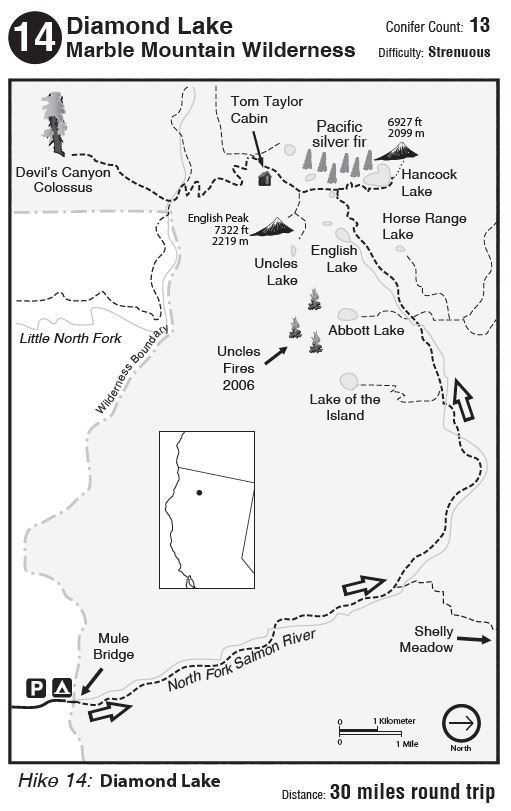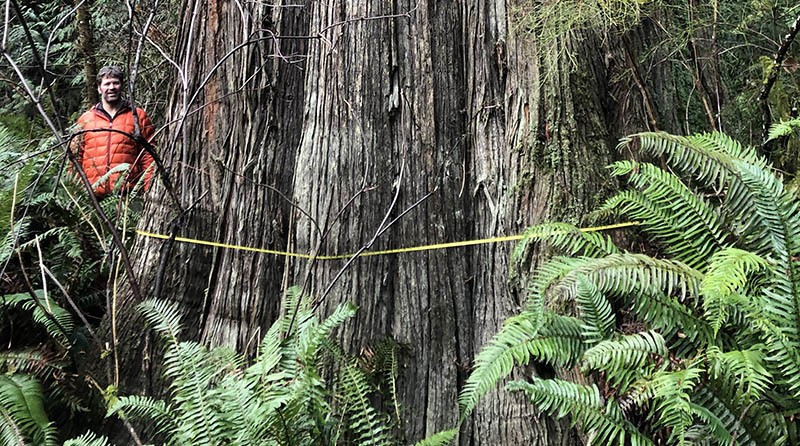Where Highway 101 hugs the Pacific Coast in Humboldt County, north through Del Norte County, Sitka spruce (Picea sitchensis) are loosing needles at an alarming rate. This phenomenon, caused by the non-native green spruce aphid (Elatobium abietinum), grew into a noticeable problem in winter 2019-2020. The aphid thrives during winters with warmer than normal temperatures. Last year’s defoliation was especially severe in Oregon and the aphids continues to move south. Sitka spruce decline in California is in its early stages.
Continue reading “Sitka Spruce Decline in California”All Species Grove
Exploring the remnant old-growth of the Humboldt County Headwaters
In late 1985, a family company in Humboldt County was over taken by a large corporation from Texas. Within a few months, the profit-driven Maxxam Corporation submitted (under the name Pacific Lumber) a furtive timber harvest plan with a rush order to log some of the last, largest swaths of remaining old-growth redwoods in the world. Thankfully, a small group of concerned environmentalists were watching. Leading the guard was Greg King who, along with others, organized and Headwaters Forest Campaign which soon became the largest forest protection civil disobedience demonstration in America’s history.
Continue reading “All Species Grove”Western Redcedar in California
From Alaska south to Oregon western redcedar (Thuja plicata) is the signature tree of the Pacific Northwest temperate rainforest. It has mythic importance to native people, as entire civilizations were sustained, in large part, by this species. Natives of the Pacific Northwest regarded the species as a “Long Life Maker” (Stewart 1984) because they used it for canoes, paddles, houses, roofs, clothes, bedding, rope, cooking, and even medicine. Few giant trees were actually felled before the arrival of Europeans because old snags were usable for many years after death. Highly resistant to rot, the snags or parts of live trees would be harvested instead of the entire live tree. After building a dugout canoe from a tree, Lewis and Clark named it “arbor vitae,” Latin for “tree of life” (Arno 2007).
Continue reading “Western Redcedar in California”Pacific Silver Fir in California
Part 2: Marble Mountain Wilderness
Read Part 1
In conjunction with the Klamath National Forest and the California Native Plant Society Vegetation Team, I completed a mapping and inventory project for Pacific silver fir (Abies amabilis) in California. The first part of this project was along the Siskiyou Crest, near the Oregon-California border. This post is about the populations in the Marble Mountain Wilderness.
In 2016 I embarked on a mapping and inventory project for yellow-cedar (Callitropsis nootkatensis) in California. At the time, I called yellow-cedar California’s rarest conifer. In 2019, new discoveries on the north slopes of Copper Butte and Preston Peak brought the total hectares of yellow-cedar in California to ~21 hectares. With this new data, and that collected in this project, we now know Abies amabilis is California’s rarest conifer*! See table below for stand data summary.
*This excludes the neoendemic California cypresses.
Continue reading “Pacific Silver Fir in California”Diamond Lake – English Peak Revisited
Marble Mountain Wilderness

I first visited this area in 2004 when my friend Jay and I attempted an ambitious loop starting from the Wooley Creek Trailhead, to the headwaters at Wooley Lake, back to Hancock Lake, and then laboring along the non-existent trail on Steinacher Ridge back to our car. This was the first major hike I took in the Marble Mountain Wilderness and my encounter with Pacific silver fir (Abies amabilis) around the Diamond Lake – English Peak region inspired the writing of my first book, Conifer Country.
Continue reading “Diamond Lake – English Peak Revisited”




